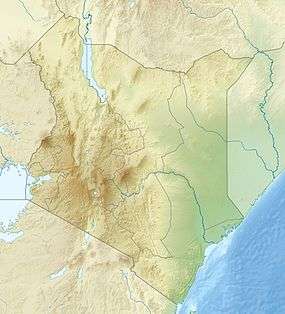Ruma National Park
| Ruma National Park | |
|---|---|
|
IUCN category II (national park) | |
 | |
| Location | Nyanza Province, Kenya |
| Nearest city | Homa Bay |
| Coordinates | 0°38′36″S 34°16′48″E / 0.6432°S 34.28°ECoordinates: 0°38′36″S 34°16′48″E / 0.6432°S 34.28°E |
| Area | 120 square kilometres (46 sq mi) |
| Governing body | Kenya Wildlife Service |
Dubbed the "Last Retreat of the Roan Antelope", Ruma National Park is the only terrestrial park in Nyanza Province. The park protects the only indigenous population of rare roan antelopes within Kenya. At present, the population is on the verge of extinction with individual populations numbering approximately 40. The park was established in 1966 as Lambwe Valley Game Reserve. It was later renamed “Ruma” after one of Kenya’s most powerful wizard, the much feared Gor Mahia who lived around the park (affiliated to Gor Mahia F.C.). The park is located in the vast Lambwe Valley. The park is assessable and motor-able all year round using three main circuits. However, during the rainy season, 4 wheel drive vehicles are advised.
Wildlife
Game species range from African leopards (Panthera pardus pardus), roan antelopes (Hippotragus equinus), eastern black rhinoceros (Diceros bicornis michaeli), Rothschild's giraffes (Giraffa camelopardalis rothschildi), oribis (Ourebia ourebi), cape buffalos, Lelwel hartebeests (Alcelaphus buselaphus lelwel), olive baboons, Bohor reedbucks (Redunca redunca), hyenas, servals (Leptailurus serval), topis (Damaliscus korrigum), honey badgers (Mellivora capensis), bushpigs (Potamochoerus larvatus) and vervet monkeys among others.
Bird watching
Over 400 species of birds have been recorded in the park, making it an Important Bird Area. The rare intra-African migrant, the blue swallow (Hirundo atrocaerulea) is one such avian species.
Picnics
The Korlang’o historical picnic site was used as escape route by the Kalenjin people during the British colonial time when they were brought to Lambwe Valley to die during the resistance, as the place was un-inhabited due to tsetse fly and malaria. Twiga picnic site, situated in the middle of the park allows clients to snack with the animals.
Camps
Two campsites are available i.e. Nyati (special) campsite and Fig-tree campsite. The Fig-tree campsite is public and a backpacker’s haven.
Other attractions
These include team building, meditation, sightseeing, wildlife research and education.
Facilities
Oribi guest house is a unique self-catering guesthouse allows clients to cherish the park’s tranquility, wilderness, scenic beauty and sunset. Three bedrooms are available and can accommodate a maximum of 6 people. The guest house is eco-friendly powered by solar energy. DStv is also available.
Park entry and charges
The park is accessible from two gates, the Main Gate (Kamato Gate) and Nyatoto Gate. Payment is by cash only.
Current tsetse status
Ruma National Park is free of tsetse fly, thanks to a collaboration of KWS, PATTEC and Kenya Veterinary Department.
See also
References
- http://www.kws.org/parks/parks_reserves/RUNP.html
- http://www.kws.org/parks/park_reserve_detail/ruma/rumapark_facts.html